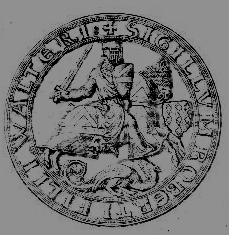 J. W. Walker2 determined
that Robert Hodd of Wakefield was married to a Matilda and that
these two may have become outlaws in Barnsdale together following
the defeat of Thomas Plantagenet, earl of Lancaster at
the hand of forces loyal to the king at Boroughbridge. Thomas had
been resident at Pontefract Castle which lay to the North of Barnsdale.
This Matilda, Walker surmised was the "Maid Marian"
first alluded to in Munday's plays as Matilda Fitzwater*
(a corruption of Fitzwalter?), later his "Fair Maid Marian".
In Munday's play, The Downfall
of Robert, Earle of Huntington it gives Marion as the daughter of Sir
Hugh Lacy, after line 781 this becomes Matilda§
the daughter of Lord Fitzwater. Compare the Fitzwalter
coat of arms with that of the Shire-reeve
of Nottingham.
J. W. Walker2 determined
that Robert Hodd of Wakefield was married to a Matilda and that
these two may have become outlaws in Barnsdale together following
the defeat of Thomas Plantagenet, earl of Lancaster at
the hand of forces loyal to the king at Boroughbridge. Thomas had
been resident at Pontefract Castle which lay to the North of Barnsdale.
This Matilda, Walker surmised was the "Maid Marian"
first alluded to in Munday's plays as Matilda Fitzwater*
(a corruption of Fitzwalter?), later his "Fair Maid Marian".
In Munday's play, The Downfall
of Robert, Earle of Huntington it gives Marion as the daughter of Sir
Hugh Lacy, after line 781 this becomes Matilda§
the daughter of Lord Fitzwater. Compare the Fitzwalter
coat of arms with that of the Shire-reeve
of Nottingham.In fact, Munday was onto something and he seems to have been incorporating
common knowledge at the time into his plays. In 1283 Adam De La Halle
produced a pastoral poem in French titled 'Robin et Marian'+
but there is no evidence that the writer was referring to Robyn
Hode, indeed I find that this poem was not referring to the inspiration
for the English ballad hero at all. This is another straw-in-the-wind which
has led down another path of futile research. The truth has been well buried
to 'protect the innocent' and perhaps the not so innocent.
Robin's camp was reported in A Lytell Geste
of Robyn Hode as being in what is believed to be Barnsdale.
Today Campsall lies around the church to Mary Magdalene, which
unusually for a country church still operates under the Catholic Church.
Robin is supposed to have left the king's service to establish a
church by this name. Local tales around Campsall tell of Campsall
church being the place where Robin and Marian were married.
Bellamy comments that Edward II may have visited Campsall
manor around 5th-6th November 1322 when Campsall manor was forfeited
to the crown by Thomas earl of Lancaster after his failed rebellion, but
Bellamy gives no reason for this assertion nor any source.4
There is also a priory at Nostell dedicated
to Mary Magdalene de Lunda. The name Marian literally means
Mary. At the time of Edward II the Church in Britain was Roman
Catholic, all services were in Latin and the political hierarchy
and courts used French exclusively in formal communication.
Matilda Fitzwalter of Little Dunmow.
A traditional folk-tale regarding 'Maid Marion' comes from
the Priory Church of St. Mary The Virgin, Little Dunmow, Essex. This
was the family church of Robert FitzWalter, leader of the
barons against King John. It was Robert who primarily forced John to
sign the Magna Carta at Runnymeade, but before this they had been on
and off friends for some time.
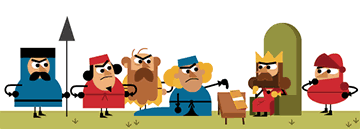 |
During an 'off' time Robert's young daughter,
Matilda FitzWalter, the "Fair Maid", had in tradition drawn the attention
of the licentious John. His advances towards her were rebuffed and
it appears from a prison record that she was locked in the 'White Tower'
[The keep of the castle of London]. She was then supposedly killed after
eating a poisoned egg given to her under King John's orders. Her body
was conveyed to the Priory Church at Little Dunmow where she was interred
beneath her effigy. Phillip Morant the Essex historian recorded another
legend of the fair Matilda :
"King John coveting this fair and precious
lady, and her father not consenting to his unlawful desires that
occasioned a war between him and the barons.....Matilda abode at Dunmow
where a messenger came to her under pretence of love, and because she
would not consent, he poisoned her and she died." Morant added sceptically
that "The story appears to me a fiction."
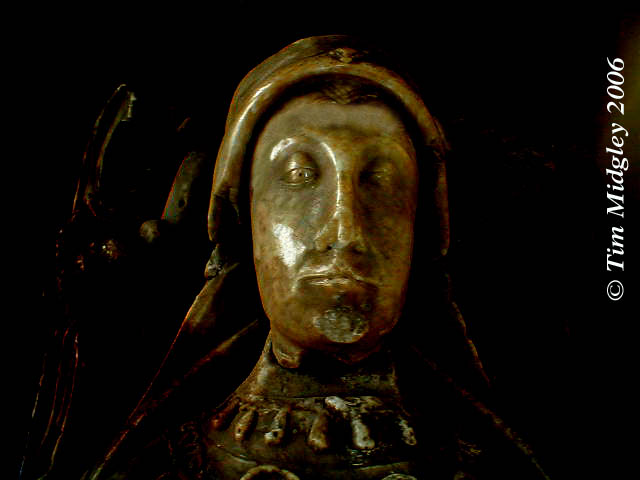
|
|
The effigy popularly thought to be that of Matilda FitzWalter daughter of the leader of the barons against King John. The nose, right cheek and forehead damage has been graphically enhanced to provide as close to the original appearance as possible. |
From this time Matilda Fitzwalter was woven into the spoken
Robin Hood stories, but was specifically included in Anthony Munday's
written plays as Matilda the daughter of Lord 'Fitzwater'. This
of course is a phonetic for 'FitzWalter', who by the 1600's as Robert
FitzWalter, had entered the hall of famed personages, a result of
his opposition to King John. Again I find that this time reference is
a fabrication par excellence. It places the inspiration for
the ballad hero falsely into the reign of King John. If one were suspicious
one might suspect a conspiracy, but there is an equally less innoccuous explanation
which has yet to be announced.
The parish history booklet provided by the chuch of unknown authorship
states: "...an alabaster effigy of a woman. The dress dates
from an earlier period than Elizabeth's [FitzWalter nee
Chiddock d. 1464].
Various suggestions have been made as to
her identity. (1) that she may be the mother of of Walter FitzWalter
[perhaps Rohese Blount], (2) 'Matilda' the
daughter of Robert [FitzWalter] the Third Baron. She is said
to have resisted the lustful advances of King John and been poisoned
on his instructions, (3)'Maid Marion' of the Robin Hood legend, possibly
because, Robert, the first baron was married to the daughter [Maud
De St. Liz] of the Earl of Huntingdon . 'Marion' has become confused
with 'Matilda'."
4. A later member of the FitzWalter family. This is suggested by the
style of dress which appears similar to that of an effigy of Elizabeth De
Strelley of Strelley Notts. which would have been the style in the late
1300's early 1400's.
Robert
FitzRichard=====Maud de St. Liz
1st Lord of Dunmow
d. of the Earl of Huntingdon
|
Walter FitzRobert======Maud
de Lucy of Diss
2nd Lord
|
____________________________________
|
|
William de Luvetot====Matilda FitzRobert
Gunnora ===== Robert FitzWalter=====Rohese
of Hallamshire
[FitzWalter]
de Valoignes
3rd Lord*
Blount
| | |
Maud de Luvetot
Matilda FitzWalter
Sir Walter FitzRobert
Hallamshire heiress
"The Fair Maid"
* =Leader of the barons against King John
Certainly the aspects of both the title 'Earl of Huntingdon' and
the "Fair Maid", Matilda FitzWalter became integrated
into Munday's plays, introducing the fictitious forest name of
'Fair Maid Marion' from both the Dunmow babblings and the May Games.
We might also note the similarity of names for Robert FitzWalter's
sister, Lady of Hallamshire and his daughter. We might question
whether there has been a muddling of the person with the name and
activity.
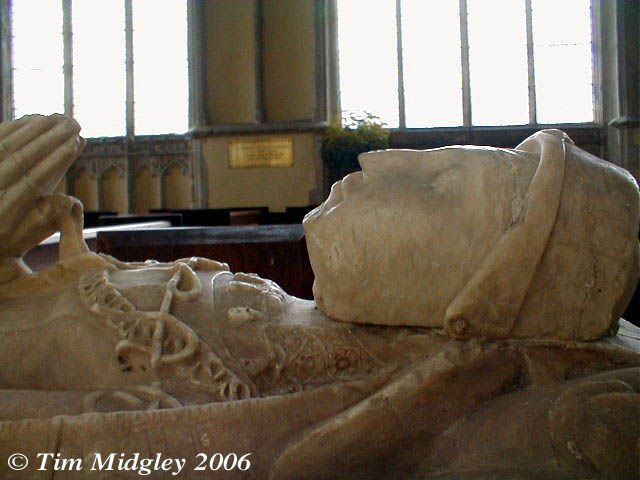
|
|
A
profile of the the effigy popularly thought to be that of Matilda FitzWalter. The end of the nose has been graphically enhanced to provide as close to the original appearance as possible. |
Matilda Vavasour aka FitzWalter/Butler/FitzWarine
In about 1199, Theobald I FitzWalter, styled Pincerna, the first butler of Ireland, married Maud/Matilda Vavasour. She was the daughter of Robert Vavasour, a sheriff of Notts. and Derbs. for two years [1235-1236]. Upon being widowed as 'Matilda FitzWalter', wife of Theobald, she now married Fulk III FitzWarine. Fulk was a lord of Whittington in Shropshire who lived in the time of King John. During John's reign, Fulk was outlawed in the period 1200 -1203. Fulk FitzWarine has often been seen as a model for Robyn Hode in the Geste. Fulk in history supported Robert FitzWalter of Little Dunmow and the baronial revolt in 1215 in opposition to King John.
.
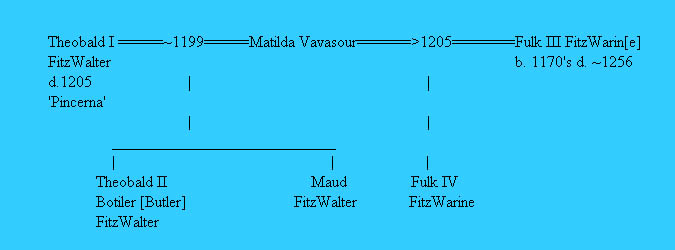
The Fulk FitzWarine romance, set in King John's time, was probably written during or after this reign. It is certainly earlier than the predicted authorship of the Geste by some one hundred years at least.
There are many similarities between the FitzWarine poetic romance, Fulke le FitzWaryn, and the Geste. Just some of these similarities are:
| Fulk FitzWarine
romance |
Robyn Hode and the Geste |
| The second in command is John,
Fulk's brother. |
Robyn's second in command is 'Little
John'. |
| John is instructed to way-lay merchants
and return them to the outlaws camp. |
'Little John' is instructed to
way-lay wealthy travellers and monks and return them to the outlaws
camp. |
| The diners are made to pay for
the meal provided by the outlaws, the diners are set free. |
The diners are made to pay for
the meal provided by the outlaws, the diners are set free. |
| Sir Moris FitzRoger seizes the
castle of Whittington, Fulk loses his claimed inheritance of Whittington. |
The Sheriff of Nottingham is Robyn's
arch enemy. Later ideas of Robyn as a disinherited lord, 'Earl of
Huntington' [Munday's plays]. |
| John FitzWarine states to Sir Moris
where he was born [The march of Scotland]. |
'Little John' states to the sheriff
where he was born [Holderness]. |
| There is a symbol of a horn involved. |
Robyn sounds his horn to his compatriots. |
| Matilda FitzWalter aka Warine is
pursued by King John. |
Although not part of the Geste,
Mundays plays [~1600] have Matilda FitzWalter pursued by the Sheriff
of Nottingham. |
| Matilda becomes an outlaw in Babbing
Forest with her outlawed husband Fulk. |
Again Munday's plays have Matilda
FitzWalter joining Robyn as an outlaw in Sherwood Forest and assumes
the name Marion. |
| The outlaws seek sanctuary in Shrewsbury
Castle with Sir Lewis. |
The outlaws repair to Sir Richard
at the Lee's castle of 'Verysdale' |
It would seem that the compiler of the Geste borrowed from the Fulk FitzWarine romance as did the Gamelyn poems and much later in ~ 1600 by Munday in his plays. One difference between the historical Fulk and the romantic version is that the historical Fulk married Matilda Vavasour whilst the romantic Fulk married Maud/Matilda De Cauz [of Laxton] who in the romance was a lady desired by King John for her great wealth. However, in reality Matilda De Cauz married Birkin and secondly Richard de Lexington, father of Robert de Lexington, the itinerant justice who was to try Rob. Hode [Hobbehod] at the York assizes in 1225. Due to his non-appearance for the trial, Robert was declared a fugitive.
.
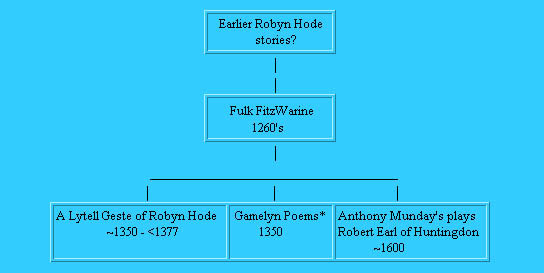
* The assumption is, that the ballad concerns Robyn Hode, although the second part of the name nor any variant of it is used.
Recent findings have shown that indeed the person who was the inspiration for the ballad hero 'Robyn Hode' did have a wife and a large number of children. This finding will 'put to bed' the scurrilous speculation that the real life hero 'batted for the other side'. In fact I find very strong evidence for the exact opposite for this assertion, the results of which are yet to be announced. The epithet 'Maid Marian' I find has descended from the place of her burial in the English countryside which became a site of pilgimage. I have © copyrighted photographs of her beautiful tomb effigy that is hidden away in a little corner of England that is forever green. This however is not the falsely claimed site at Little Dunmow, which in itself has a very interesting re-interpretation.
References/Sources :
1. Munday, Anthony. The Downfall of Robert, Earl of Huntington, 1598 - Munday changed the venue from Barnsdale to Nottingham & Sherwood and names Robin Hood as the Earl of Huntington#. He also moves the time to Richard I and King John. He introduces Maid
Marian perhaps from the May Games.
2. Walker J. W. The True History of Robin Hood, Wakefield, 1973.
3. A Brief History of the Village and Priory, Little Dunmow. Dunmow Design and Print.
4. Bellamy, John. Robin Hood: An Historical Enquiry, London,1985, p.80 5. Phillips G. & Keatman M. Robin Hood The Man Behind the Myth. Michael O'Mara Books, 1995.
Notes :
*Fitz = "illegitimate son of the royal blood line" as in FitzWilliam/FitzWalter etc. Fitz is a corruption of Filii "of the family" (see seal above).
# = There are only two places named Huntington in England, one is N.E. of York City, the other in Herefordshire.. Huntington may be interchangeable with Huntingdon given the phonetic provincial spelling.
§ = Matilda is synonymous with Maud.
+ = Marian in French, Marion in Scots & English.
© Tim Midgley 2000, internal links revised July 2023.